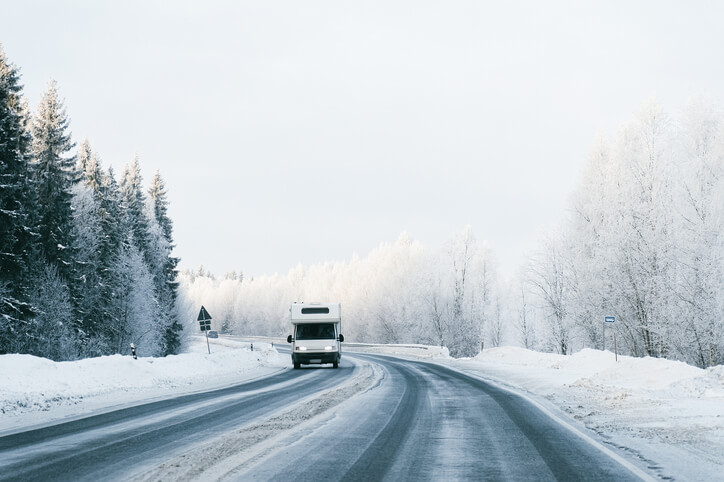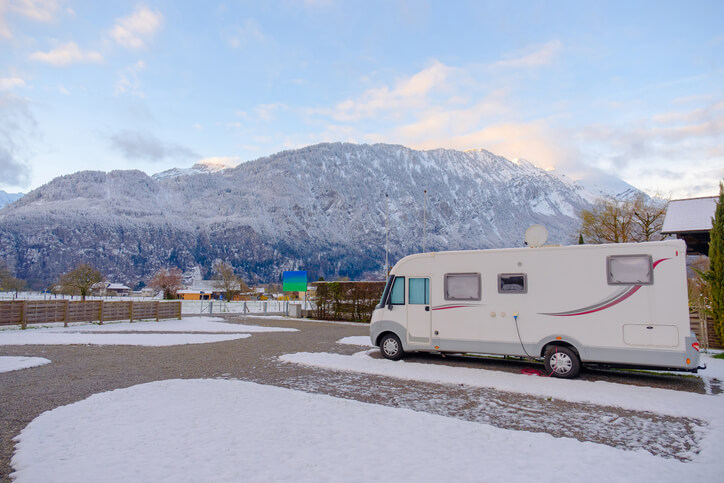10 Things to Remember for Winter RVing
Contents
Summer is over, cold weather has arrived, and you miss the open road. Many RV enthusiasts will take winter as an indication to head for warmer climates. They pack up their RV with gear and drive to Arizona, California, or New Mexico—all wonderful places for RVing. Some adventurers, however, take this season as an opportunity to see the incredible snowy wonderland that only winter provides.

As you might expect, winter RVing presents some challenges in preparation, maintenance, and overall comfort. Simply put, it’s cold. The ice and snow are beautiful, but seeing and experiencing that beauty takes a little more effort than RVing in the summer. Pipes and fuel lines need proper care, the interior of the RV needs to be heated, and you want to be safe about the methods of preparation you use.
Listed below are ten pain points and potential issues that may come up during winter RVing. We have provided tips on each of those areas in the hope that you, the RV adventurer, can get out and enjoy the season without interruption.
1. Sealing and Insulation
One of the most important things you can do to ensure a comfortable winter trip is to seal and insulate as much as possible. Keep cold air from seeping in the entry door and windows by insulating these areas with curtains made from heavy, durable cloth. Seal the curtains to the wall with velcro, snap-on fasteners, or other removable products. On the exterior, consider adding thick plastic panes or Lexan to keep in even more heat.
Several tips in the rest of this article involve keeping your RV’s inner workings warm and functioning. Sealing and insulating, however, is all about keeping you warm, so don’t neglect this side of winter prep. Take the time to seal every potential crack and crevice through which freezing air might seep, and don’t be cheap in the materials you use. This is your comfort we’re talking about—it’s worth it.
2. Plumbing and Water Tanks
Keeping your water and filters from freezing is critical. Line the floor of your RV’s water bays with a layer of safe insulation, and purchase a small space heater that will fit inside the bay. Both of these items will keep the plumbing and freshwater bays from freezing without running the expensive propane heater. To monitor the temperature inside the bays, consider buying a thermometer that you can check from a device inside the RV.
Quick tip: detach and store your sewage hose after use. It will get brittle and freeze in the cold temperatures.
3. Washing Your RV
Washing your RV during the winter is less than enticing. Who wants to sud and scrub any vehicle in the freezing cold? Unfortunately, traveling in the winter months takes a toll on the exterior of your RV, covering it with dirty slush, snow, ice, and mud.
If possible, find somewhere inside or under a cover to wash your RV. It’s critical that the washing is done quickly and efficiently, and that you dry the RV afterward. Soapy water will clean every part of the vehicle, but if it is allowed to stay there, it will freeze and cause damage. Also, whatever you do, do not use hot water to de-ice the windshield. The drastic temperature difference can lead to cracking and eventually you’ll need to replace the entire windshield. Take the safer route and simply use a scraper and brush.
4. Slide-outs
For RVs with slide-outs, it is essential to clean the snow and ice from the awning. Accumulated snow puts unnecessary stress on the slide-out, and when the heat from inside the RV begins melting that snow, you run the risk of water damage. Ice can also gather on slide gaskets and make it difficult to retract the slide when it’s time to go. When it comes time to go, spray verified RV antifreeze on the gaskets and close up all slides the night before you leave the campground.
5. RV Skirting
If you plan on staying in consistent freezing temperatures, it will be worth investing in high-quality skirting to install around the coach of your RV. This will keep a significant amount of cold air from seeping into the undercarriage and freezing your pipes, tanks, and more. A more cost-effective way to make skirting is simply shoveling snow against the coach. It will act as insulation surprisingly well. Just be sure you don’t block exhaust vents with the snow; dangerous CO2 emissions must be removed from inside your RV.
6. Interior Heating and Humidity
You probably don’t need to be told how important it is to heat the inside of your RV. Most RVs have a propane furnace that works great for staying warm during cold nights. But other more affordable options include space heaters and even pellet stoves. If you plan on spending weeks at a time staying in the snow, it’s worth exploring your options. Don’t forget to clear and clean ceiling vents to remove any humidity caused by the propane heater. Humidity can cause moisture to build up on the walls and windows that have the potential to freeze.

7. Fuel Supplement and Wiper Fluid
Before you head to the mountains, buy some diesel fuel supplement and winter wiper fluid. The fuel supplement will keep the diesel from gelling, which can cause major issues in your engine and fuel lines. The Winter wiper fluid will be extremely helpful when you’re driving through dirty slush and snow.
8. RV Tire Chains
Most states require tire chains for snowy travel. If you plan on traveling to mountainous regions or even driving through a mountain pass, this is a matter of personal safety, not simply laws of the road. The last thing you want for your RV and family is to spin out of control on the road or become stranded at a rest stop of a campground.
Remember, there are preventative measures you can take to avoid getting stuck in the snow. Watch the weather report carefully before leaving, noting the predictions for both the road to your destination and the destination itself. Winter RVing is all about preparation, and finding the right time to go is part of it.
9. Handy Tools
Go to your local hardware store and stock up on a snow shovel, ice scraper, and a bag of de-icer. Whether you’re constructing a makeshift RV skirt (snow against the coach), cleaning the outside of the RV, or preparing to leave the campground, you’ll be thankful for a simple shovel. These items are small, but they can prevent quite the headache.
10. Get Cozy
Finally, cozy up the inside! Winter RVing is all about experiencing beautiful snowscapes and icy wonderlands, but it does not need to include shivering at night. Save the freezing temperatures for tomorrow’s hike—you’re staying warm tonight.
Invest in a nice, large down comforter for your bed. Bring along plenty of blankets, warm clothes, and house shoes for walking on chilly floors. Also, as mentioned above, space heaters are a great addition to a winter RV trip. They are affordable, small, and if you’re connected to shore power, you won’t be using the expensive propane in your furnace.
Contact Kirkland RV to Get Started Today
Kirkland RV is the most reliable, competitive new and used RV dealers in the Seattle area. We offer a great selection from high-quality manufacturers, with a sales team that is dedicated to helping you choose the best RV for your needs. For more information, call us or fill out the form at the bottom of the page.

